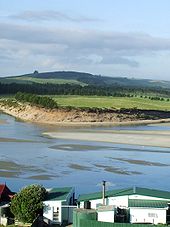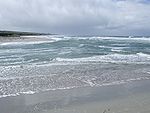
Toko Mouth
Encyclopedia

Tokomairiro River
The Tokomairiro River is located in Otago, New Zealand. It flows southeast for some 50 kilometres , reaching the Pacific Ocean at Toko Mouth 50 kilometres south of Dunedin...
, some 50 kilometres south of Dunedin
Dunedin
Dunedin is the second-largest city in the South Island of New Zealand, and the principal city of the Otago Region. It is considered to be one of the four main urban centres of New Zealand for historic, cultural, and geographic reasons. Dunedin was the largest city by territorial land area until...
and 15 kilometres southeast of Milton
Milton, New Zealand
Milton is a town of 2,000 people, located on State Highway 1, 50 kilometres to the south of Dunedin in Otago, New Zealand. It lies on the floodplain of the Tokomairiro River, one branch of which loops past the north and south ends of the town...
in Otago
Otago
Otago is a region of New Zealand in the south of the South Island. The region covers an area of approximately making it the country's second largest region. The population of Otago is...
, New Zealand
New Zealand
New Zealand is an island country in the south-western Pacific Ocean comprising two main landmasses and numerous smaller islands. The country is situated some east of Australia across the Tasman Sea, and roughly south of the Pacific island nations of New Caledonia, Fiji, and Tonga...
.
The settlement comprises some 70 holiday homes, of which a small percentage are occupied by permanent residents. It is accessible by road from Milton and also via a coastal back-road from Kaitangata
Kaitangata, New Zealand
Kaitangata is a town near the coast of South Otago, New Zealand, on the left bank of the Clutha River ten kilometres south east of Balclutha. The town is known to its residents simply as Kai....
, 20 kilometres to the southwest.

Cook's Head Rock
Cook's Head Rock is a phonolite basalt rock standing on the Chrystall's Beach expanse closely north of the rivermouth settlement Toko Mouth of South Otago, New Zealand. The lower faces of the rock are made up of numerous hexagonal basalt columns suggesting Cook's Head Rock is a former volcanic vent....
, a rock formation featuring hexagonal columns. Bull Creek is a popular site, as the small beach is surrounded by a stand of native bush and is sheltered by a reef. Swimming is relatively safe at both Bull Creek and Toko Mouth, though rips are common at Chrystall's Beach.
The estuary
Estuary
An estuary is a partly enclosed coastal body of water with one or more rivers or streams flowing into it, and with a free connection to the open sea....
just inside the mouth provides a food source for several species of water birds, including oystercatcher
Oystercatcher
The oystercatchers are a group of waders; they form the family Haematopodidae, which has a single genus, Haematopus. They are found on coasts worldwide apart from the polar regions and some tropical regions of Africa and South East Asia...
s, spoonbill
Spoonbill
Spoonbills are a group of large, long-legged wading birds in the family Threskiornithidae, which also includes the Ibises.All have large, flat, spatulate bills and feed by wading through shallow water, sweeping the partly opened bill from side to side...
s, gull
Gull
Gulls are birds in the family Laridae. They are most closely related to the terns and only distantly related to auks, skimmers, and more distantly to the waders...
s, heron
Heron
The herons are long-legged freshwater and coastal birds in the family Ardeidae. There are 64 recognised species in this family. Some are called "egrets" or "bitterns" instead of "heron"....
s and others. A reef is found outside the southern side of the mouth. Shortly up river, the wetland
Wetland
A wetland is an area of land whose soil is saturated with water either permanently or seasonally. Wetlands are categorised by their characteristic vegetation, which is adapted to these unique soil conditions....
is home to a notable population of Fernbird
Fernbird
The Fernbird is an insectivorous bird endemic to New Zealand. The Māori names are Kōtātā or Mātātā. It is a rich brown above and white below, with brown spots on both the throat and breast. Early settlers called it the "Swamp Sparrow" no doubt because of its colouration. The tail feathers are...
, and the occasional bittern
Bittern
Bitterns are a classification of birds in the heron family, Ardeidae, a family of wading birds. Species named bitterns tend to be the shorter-necked, often more secretive members of this family...
.
From the earlier months of 2007 it has become apparent that the spit which buffers the river mouth has been moving erratically with each successive tide, wearing down to nothing but a stub. Heavy rain and wind has caused this occurrence.

